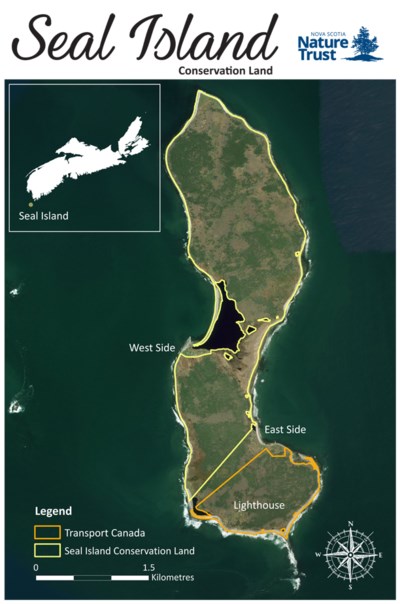Nature Trust secures protection for 650 acres of Seal Island
Posted Aug 17, 2019 04:44:00 PM.
This article is more than 5 years old.
Calling it a “big win” for the migratory birds that call the island home, the Nova Scotia Nature Trust announced on Friday that no private development will occur on the island.
Seal Island is located 32 kilometres off the coast of Southwestern Nova Scotia.
The announcement was made yesterday in Clark's Harbour on Cape Sable Island, the area from which people typically depart for the more remote island.
“Protecting Seal Island, one of the most important islands for migratory birds in Atlantic Canada, is a major win for bird conservation and recovery,” says the Nature Trust’s Executive Director, Bonnie Sutherland.
The protected area, 650 acres, includes the Seal Island Conservation Lands, which encompass over 80 per cent of the island.
The remainder of the land, which includes a lighthouse, is owned by Transport Canada.
 A map showing which area of the island is now protected. (Photo: Nova Scotia Nature Trust)
A map showing which area of the island is now protected. (Photo: Nova Scotia Nature Trust)
The significance of Seal Island is partly due to its landscape, which includes a diverse range of habitats including salt marsh, rocky shores, sandy beaches, forests, and grass dunes, among others.
The island's location is also directly in a migratory bird flight path called the Atlantic Flyway.
Over the years, over 330 species of bird have been documented on Seal Island, including 20 that are designated species-at-risk.
This includes Roseate Terns, Harlequin Ducks, Canada Warbler, Rusty Blackbird, Red Knot, Barn Swallows, and Atlantic Puffin.
The location is isolated from the mainland and mostly untouched by humans, which allows birds to lay low during storms, breed on the island, and spend winters there.
It's also the first stop for birds migrating from more tropical areas, or a stopover for those flying South for the winter.
“[It's a] critical refuge for birds to refuel and replenish on their long migratory journeys,” says the release.
Eric Mills, an avid birder who has visited the island almost every years since 1967, says he's delighted that the island can continue to provide food and shelter for migratory birds.
“Ensuring these necessities, especially at Seal Island — the critical beginning or ending point of their long migrations — is a highly significant,” he added.
Seal Island has not been inhabited by humans year-round since the 1990's, but in the warmer weather it is home to fishermen, birders, and local families who have been connected to the island for generations.
The Nature Trust says 96 per cent of coastal islands in the area are privately owned, and only about 6 per cent of those are protected.
Seal Island was protected with the financial support of the Government of Canada's department of Environment and Climate Change, the Nova Scotia Crown Share Land Legacy Trust, as well as families and individuals.
The Nature Trust aims to continue working to protect more land, and to further protect Seal Island.
“The Nature Trust is already working to secure its next island win for birds,” says the release.
For more information, visit nsnt.ca.








